APTA Rail 2010: Canada Line session
APTA Rail 2010: Canada Line session
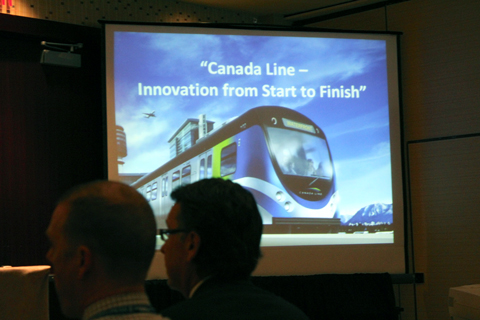
First, a note for students who are planning to attend this week: The Canada Line and SkyTrain technical tours are already fully booked. Don’t come down if those were the only things you wanted to see! I wasn’t lucky enough to get on either of them, so if anyone has gone through them I would love to share photos and notes.
I’m at the 2010 APTA Rail Conference downtown from Monday through Wednesday, and since I’m going to a lot of sessions, I’m just going to give you my notes from the talks, in the interests of getting things online faster.
“Canada Line: Innovation from Start to Finish” was a session moderated by SkyTrain CEO Doug Kelsey in the morning. There were three parts to it: the first had speakers from TransLink; the second had speakers from ProTransBC, and the third was speakers from YVR, all discussing the Canada Line from their particular perspective. Then questions were asked by the attendees.
Bear in mind that this is a conference for transit professionals, so the aim of the session was to outline the process that put the Canada Line public-private project together and talk about the contract and partnerships from an implementation perspective.
Doug Kelsey: introduction
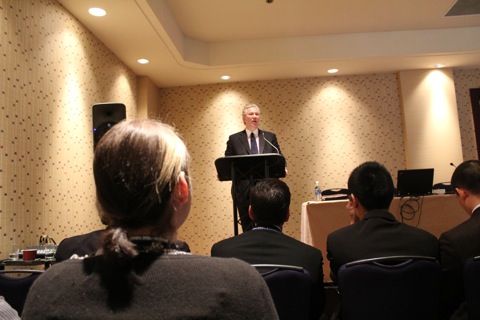
– here’s a little bit about Canada Line today
– contract – can probably take ¾ of this table up
– It’s a complex agreement and a lawyer’s paradise
– early ridership stats are coming out very well
– ultimately alignment drives what kind of corridor and capacity you have
– integration of buses has been an important part of success
– hope to share a lot of that with you today
– 1st presenter is Ron Aitken and Dennis Cook from TransLink
– they are responsible for management oversight for Canada Line under PPP model
Origins of project and initial partnerships: Ron Aitken from TransLink
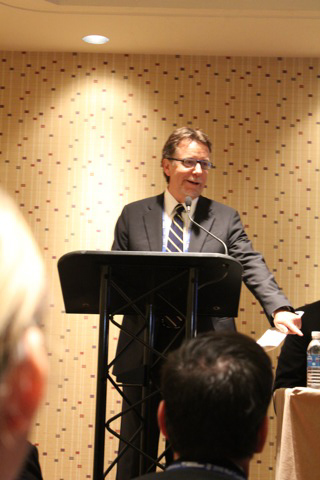
– Our project is about start to finish: i’m the start
Project rationale
– the project goes back over 20 years ago
– Vancouver is constrained with mountains on one side, oceans on the other
– the most fertile farming land at south and the U. S. border
– so trying to sort out where the high density growth is located is an ongoing question
– this alignment has been on the register for many many years
– and what helped us confirm this is the right alignment
– we saw growth in richmond and city of vancouver
– we were building up rapid bus service up and down corridor
– when we looked at corridor again it’s got about 30% of region’s jobs, plus or minus
– it has 20% of the population
– these things were overcongested
– if anyone has ridden the system, it becomes much more than a commuter line
– it serves so much more
– if you’re going in through south you go through tunnel or under a bridge
Partnerships
– lots of work being done by Canada Line Corporation (CLCO), a special purpose company, wholly owned TransLink subsidiary
– had many masters in fed govt, prov govt, city, us at TransLink
– these people tried their best on landing on the objectives, what we need to do, can we deliver on time and under budget
– there’s probably 10 pages of objectives but i tried to pick ones that are relevant.
– so some of the project objectives are: increase capacity of corridor; improve travel times and access to YVR; help environment; help city development; support Olympics; minimize capital and operating risk
– what helped us a little bit to make sure we were working on time and delivering
was this little sports competition early in the year
– so people not familiar with CL
– it’s an automated driverless system
– train control system is via thales
– it’s the next generation of what’s used on skytrain
– 19km 16 stations
– a greenfield project
– right now we have 20 2-car trains in the city delivered by Rotem
– contract value is $2.1B CDN
– when we look at the alignment we replace about 10 traffic lanes going into the city
– the winning company, a special purpose company InTransit BC, they did a fabulous job
– the engineering procurement company was all snc lavalin partners
– and created operating company protrans which is all SNC Lavalin
– so getting system built getting operations done on time is due to InTransitBC
– from my seat the project is very very successful
– and we’re proud to say that it’s one of the largest if not the largest PPPs
– and certainly the largest when it comes to transit
– it’s a design build finance operate maintain contract
– a 35 year concession including construciton period
– so we’re brothers for next 31 years through contract
– by contract system due to complete by Nov 30, and it was over 3 months early
– payment milestones
– because we had so many stakeholders
– the decision taken early on to say that engineers would take an independent look at project
– so we all were comfortable making our payments
– Funding partners — gives you a flavour of the partners in getting this project done
– federal govt was in for 450M prov 250M
– airport over 250 tl 340m
– InTransit BC invested 720m, that’s money at risk through the operating period
– that’s kind of a picture of what these people did: a fantastic job at making sure things were delivered and being paid for on time
Contract structure and operating period: Dennis Cook from TransLink
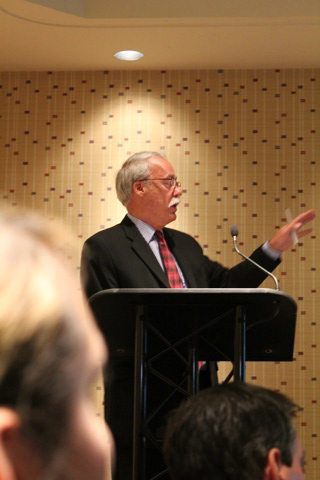
Will talk about contract structure and operating period
– focus on relationship of concession agreement
TransLink → concession agreement → intransit bc (in charge of PROTRANS BC)
– performance and how they get paid
TL retained responsibilities
– TVM and revenue collection, security, police; customer service, shared lost and found; policy, bileks, hours and ops service planning; tariff
– these are pushed out to units throughout enterprise with ability to do the job
– TVM — TL corporate already has a revenue risk body that takes care of the tariff and faremedia and revenue sales, that sort of things, and they now handle canada line
– operation maintenance tvms – BCRTC does this
– on revenue side — CMBC has responsibility for collecting revenue for seabus, wce, skytrain, bus fareboxes, and now canada line
Concessionaire’s Ops & Maintenance requirements
– contract specs secured through payment mechanism
– minimum operating hours
– maximum travel times headways and dwell times
– service and staffing plans
– asset mtce, vehicle station cleaning & maintenance etc
Service and capacity
– within first two year period an initial service plan will be run
– specifies frequencies run with the shortest headway 3.75 min and longest is 10 min – that’s for main branch of line between Waterfront and Richmond-Brighouse
– trip times by contract are 25 and 26 minutes (longer time is to YVR)
– and capacity initial service plan is 6400 at 400 per car
Recent performance
– since we opened on Aug 17, 2009
– ridership is typically within any week ridership ranges from low of 95 000 to 115000 peaking on Friday
– on weekends ridership drops to 65000 to 85000 per day
– if we were to take the olympic period out and say what is the growth in ridership
– took november and compared to april — 9% increase in ridership in that period
operating period payments
– are monthly and schedule based and reflect three categories: volume (10%) availability (70%) and quality (20%)
– special event payments — TL responsible for identifying special events
– initial ridership based on service commencement and updated on the second anniversary, then every fifth anniversary
Early performance
– example shown: period 10 ending may 19 2010
– vehicle availability 100%, quality 100%, station availability 100% station quality 99.86%
– station quality reflects issues with escalators and elevators
– so for if platform information displays down there is a grace period, and after 2 hours a penalty kicks in
– this is true of many things in the system – graffiti, elevators, esclators
Managing the Concession
– monitoring of conformance to concession
– three of us that administer the contract
– we reach into the organization for the things we have to do to administer contract and to support translink with its obligations and what it has to do.
Canada Line operations and ridership: Jason Chan from PROTRANS BC
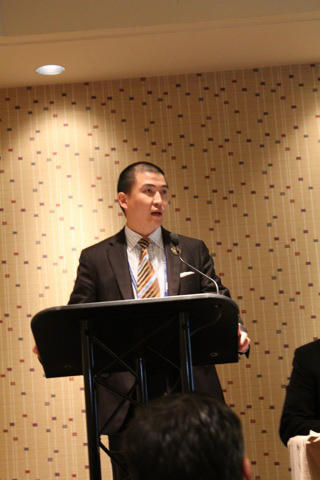
Doug Kelsey: Jason is the manager of communications for PROTRANS and was a member of InTransit BC
joining him is Paul Lam – analyst joined in 2008, previously worked for thales
from dubai metro, and worked on various ATC system – Jubiliee line and Guangzhou Metro Line 3
Jason:
– summary: insight on what has happened in last 9 months, stats, ridership so on and so far
– PROTRANS is private operator wholly owned by SNC Lavalin; report to their ops & maintenance division; SNC lavalin board of directors governs
– they sit south of Fraser in Richmond
– We currently employ 200 full time employees
– ops & maintenance contract is three pronged
– responsible for operation of railway
– responsible for front line customer service (anyone rode in from airport noticed the green coated canada line attendants)
– and last we are responsible for maintenance of all system assets
– With ops of railway we currently serve approximately 100,000 weekday
– 8,000 train km run daily (in miles, about 5,000 miles)
– control room is 24/7 and employ 24 control room operators and supervisors
Customer service
– we employ over 100 customer service reps
– these are CLAs and station attendants
– highly trained and skilled in customer service as well as field response services
– you’ll see them on trains on platforms providing any services ranging from wayfinding related services
Maintenance
– Protrans bc responsible for maintenance for entire system, all fixed assets and rolling stock
– as ron and dennis mentioned we currently have a fleet of 20 2-car trains
– all produced by rotem hyundai
-we currently employe about 67 maintenance staff on part of our maintennce engineering group
– before we get to providing with stats on ridership and early success
– i want to touch on what makes us successful and what we saw as key ingredients – for making this a success
– this was delivered on budget and ahead of schedule
– 110 days, ahead by 3 months
– the most important part of success: the foundation for success of a railway is the handover
– the testing commissioning and handover from epc to ops and maintenance
– our one team approach was the key to the early success
– SNC Lavain was the EPC owner and PROTRANS was the operator
– we were intimately involved intesting /commissioning phase
– and led to us successfully passing the 12 day service reliability demonstration test
– also being registered to IS 14001 prior to commencement on Aug 17
– 3 months ahead of schedule
– because of this, because of the setup, we could make this a turnkey operation in maintaining our early success
Opening Day
– Aug 17, 2009
started with opening day with 8h long fare free period
saw 82,000 passengers experience line at first time
pictuers shows lineup for Waterfront station
that’s about a 4 block long lineup
was there 7am and was there 10 pm at night when we closed up shop
Now to pass on to Paul to talk about system features
Features of Canada Line system: Paul Lam, PROTRANS BC
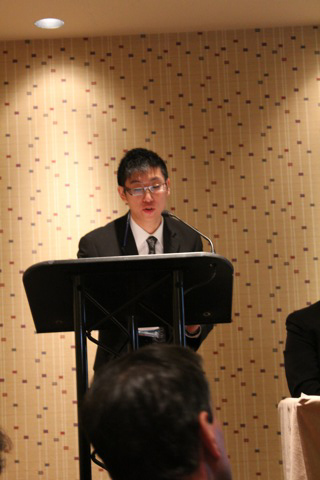
– CL runs on system build by thales rail signaling
– it’s an induction loop based communication as compared to track circuits
– it’s moving block system not fixed
– it’s currently similar to vancouver skytrain, dubai metro
– being driverless in terms of train service, you can increase on the fly without to preschedule extra drivers or attendants
– in case of service delays we can divert around obstruction without possibility of miscommunication between control and driver
automatic train control (ATC) territory in canada line extends into yard and main line
– so when we route train can run them into storage lane, and it can shut off lights
– and park by itself
– when we put it into train line it can be cleaned all by itself
other ATC features include a Automatic recording of ATS screen for replay and analysis
– can see its boundary and authority
– it also comes with a full simulator which shows vast majority of ATC problems
other notable systems
– performance monitoring system which automatically calculates performance according to terms of P3 contracts
– at end of period it automatically generates the invoice (this got big laughs)
– when you walk into a canada line station you may notice automatic passenger counters at all stations
– now weekday ridership is 100-105,000 per day on weekdays
– which is about 24% above pre revenue forecast
– here’s ridership breakdown by station
Rider distribution
– downtown 32% (destination of many commuters)
– cambie st corridor 35%
– city of richmond 23%
– yvr airport 10% — expected to rise further as we get into cruise ship season
Jason: I want to add that if you look at the graph there are certain hotspots broadway city hall is a major connection to cmbc system for the east west corridor again
Performance to date
– Ridership on a typical weekday
– can see a clear am pm peak
– but can also see a significant weekday ridership associated with entertainment venues etc
Olympic Winter Games experience: Jason Chan, PROTRANS BC
– let’s not beat around the bush
– any one of us who joined this project early on before revenue service
– all knew right away that our biggest challenge is 2010 olympic winter games
– all my colleagues in attendance will agree that we got our hands full
– something we planned for and looked forward to
– didn’t expect some of the ridership turnout
Olympic games ridership demand
graph shows green bars — our average ridership from revenue service to shortly before olympic ridership
blue bar shows expected ridership
targets or forecast was compiled with help of translink and previous games experience data
but as we all know we were the biggest city to host a Olympic winter games so we can only expect more
Peak ridership was the Feb 19 sunny day of the games
– 287 000 passengers rode that day alone
– cumulatively we carried over 3,881,986
– if you add on day of reshearsals anda fterward, we had over 4M passengers
– we usually run 14 train schedule
– with the help of control room
– we were able to set up an extra service plans for 16 and 18 trains
– and as anyone in the project knew, everything went out the window 3h into the first day
– eerie experience when you walk into train hall and there’s no trains in sight
– we ran 20 trains all day full fleet
– which is a great testament to our engineering and maintenance folks
– if you can imagine 20 trains all routing back to the hall at 1, 115 in the morning
– and having to get them back on tracks for 430 for first train at 445
– and testament to field staff
– everyone pulled up socks and put in extra hours
– and everyone who has experienced an olympic games knows lining up is an spectator sport
– games pavilions all had lineups
– but our average lineup for boarding was 5 minutes longest was 20 minutes
– for the whole 17 days we only had 1 minor delay and that was due to a door fault
– and that was the most minor delay a transit system can have
– we did pretty well moving 4M passengers over 17 days
– in summary i’d like to close and say we are the only air rail link in Canada an the first
– we expect ridership to steadily increase through conversion factors from non-transit riders/drivers; from a positive experience during the busiest time; and by giving people more reasons to come back
– Canada Line only enhances vancouver’s stature as a global canadian city
Airport involvement in Canada Line project: Dave Harkness, YVR
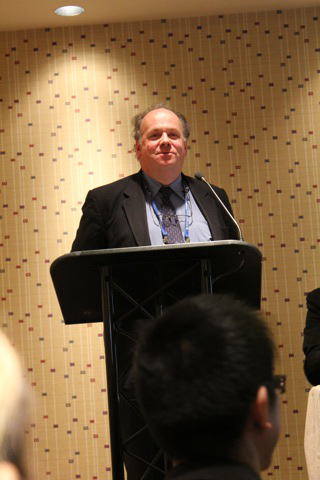
YVR
– 16M enplaned deplaned passengers
– 12M origin destination passengers
– that’s half the size of Seattle
– YVR is a private corporation, not a public one
2027 master plan
– identified ground access as a critical issue
– we’re on an island, at the western edge of metro area, growth is south and east, and no new road growth planned for us
needed sustainable ground access strategy
– wanted to improve the speed and reliability of access, reduce emissions, etc
Canada Line at YVR
– is an intra airport people mover
– connects to public transit
– there’s an at grade section on YVR
– because we want to build a flyover taxiway in the future
– so integration with master plan was very important
Three stations
templeton – servers future comm development and remote employee parking
sea island centre, serves hangars, flight kitchen cargo
terminus is for passengers
Transit access pre Canada Line was a local bus connection that met up with a BRT
Transit mode share 3% of passengers, 9% of employees
after the Canada Line opened, you could see the impact on ppl mode split
red circle
transit mode split for passengers went from 3% to 15% – a remarkable change
airporter bus went out of business
but we’ve seen impacts on parking revenues
people parking fell from 41% to 38%
dramatic change in mode split
so this slide shows the share of passengers taking transit to a number of diff places
European airports do very well
in North America and Australia we’re in the middle of pack
so we’re very happy as an airport authority with the success fo the line and the satisfaction customers have had
CL to YVR
who’s riding it? Did a survey in october
58% airline passengers
20% employees
16% greeters well wishers
6% observation deck/otehr
what surprised us was the 16 and 6
now it’s easy to get to, people visit it locally
so that’s a pleasant surprise
How ppl got to yvr before
17% drove and parked
32% dropped off pickup by car
25% taxi
25% transit
1% other
How people get to canada line
62% connect via other part of transit system
30% walked
6% pick up/drop off by car
2% other (skateboarded or something)
How likely would people use it again
88%very likely to use it again
7% somewhat likely to use it again
Effects of Canada Line on YVR: Mike Brown, YVR
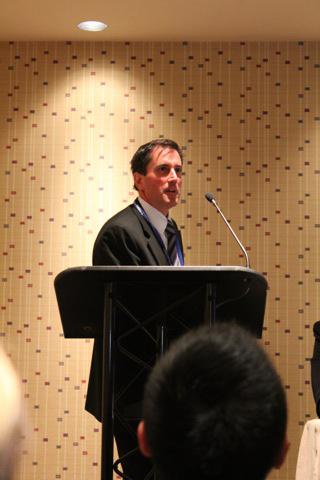
Will talk about impact on parking and ground access
Anticipated through 2010 initiating a 60M project o expand parking facilities
With numbers on Mike’s charts, project has been deferred
Don’t want to talk about impact on parking revenues
But it’s a great sustainability outcome
it’s had a significant outcome, a multimillion dollar impact on what we used to use for parking revenue
one other side benefit is we previously operated about 7 shuttles 24h a day
to move our employees from parking lots to the airport and the terminal
and when we built the Templeton station
we also created a 2500 stall parking area and centralized employee parking areas
it’s an intra island service
we could eliminate the 6-7 buses, removed cost, GHGs, and the employees take the canada line
Impact on ground transport operations
airport terminals keep the curb side that they’re born with or built with
when we refer to curb side we refer to front of house curbside access
over the years that of course gets taken up by passenger use
that gets constrained
after a number of years you’re always short of curb space
it’s a unique situation to replicate that curb space
with the templeton lot
we created 440 linear feet that replicates 2 levels of tour current curb side
and that was particularly useful during the Games
we had 195 commercial operators moving athletes, the public, who normally were used to coming to curb space at the terminal
but we had turned over 60% of curb space to vanoc which used space to move athletes etc
but by shifting curb operations to Templeton, the satellite curb, we were able to make the main terminal curb work
this will be used as a legacy
for a 2-tier pricing for curb access
can secure it for a lesser price
Olympic Games experience truly was critical
we were concerned: we’re an island with 3 bridges to connect with surrounding municipalities, and this was winter games
so we were anticipating the same kind of heavy snowfall we’d see in 2009
effect of doubling of traffic through airport had to flow through normal roadways
without Canada line we would have been concerned
but weather cooperated
the media the olympic family and the public just flocked to the canada line
Doug mentioned too a program to encourage people to leave their cars behind
that got a lot of people out of their cars
we saw a great benefit to that
he only thing that scared us was departure day
47,000 departures, which is 2x our average day
was worried everyone would get on CL
and we pictured every 6 minutes 400 people coming onto the airport and engulfing us
PROTRANS operated 24h through maintenance periods
but just over all not worrying about roadway constraint was a huge gift to us
and in terms of sustainability
we’re well ahead for modal shift for passengers
we are looking at 3,000 fewer cars coming to the terminal to drop people off, park
and a small number that mike picked up earlier in the game
we’ve situated all the parking on the east end of the island
6,000 employees are doing a shorter trip, add it up over the year
contributes a huge amount to green house gases
many good things to say about the line
the impact to the airport can’t be overestimated.
Questions
Q: I’m interested in how the $259M airport share was determined, and #2 how was the revenue generated from the project and what was the view of air carriers about it.
Mike Brown, YVR:
cover as much as i can
limited that in i wasn’t there for early negotiation and engineering
limited understanding is that the air carriers viewed it as a welcome initiative
funded through airport improvement fee
collected as part of ticket for originating/destination passengers
all infrastructure on sea island including the three stations is what we paid for
Q: In concession agreement, who is responsible for fare inspection?
Ron Aitken, TransLink:
By contract the operating company has a respnsibility for doing fare checks
what you might be aware of is that we also have TL transit police that equally do their checks as well
but i’d say that we get a report from PROTRANS every 28 days
they declare how many people are on the line and how many offenses are occurred
it’s relatively low i’ve got to say
Q: are these different people all from skytrain?
Doug Kelsey:
we call it all skytrain, so people will see one system
CLAs are canada line attendants, on SkyTrain you have STAs
different folks, staff of respective enterprise and enforce the tariff
they have limited restrictions but cannot write tickets with dollar amount attached
but police are part of our enterprise translink
separate policing unit
one of the challenges unique to our unit
we have 22 municipalities for population of 2.2 M
that has advantages/disadvantages
and from policing side it was problematic
so we had to change the rules of the game and that’s what we did
Q: more a comment than a question
I have been in business trying to help people optimize track
with extreme high level of cooperation
I am fully convinced that this is a model, if you were allowed to apply it to different places in North America, this would have hundred of millions of savings
and there has been no system that has opened in this manner with pre-engineering work done
i’m originally from canada and am proud to see what you have done here
i don’t think the skytrain got near the credit for how it worked
one detail i don’t see here is not so much the technical skills it’s the people and how they worked with each other
this is only place we can go to to see there is a segregation between operations and planning
and there’s been a lot of design build maintain contracts
you have a contract structure that is synergistic that allows people to deliver a safe reliable system
i don’t think there’s anything in north america that’s close to what you’ve done
Doug Kelsey, SkyTrain CEO:
we’ve had a lot of lessons learned too
in anything when you’re building it for the first time
it’s painful and hard and you’re giving birth to something new
but there was senior level of government involved to make sure ppl were in
this is a 100 year system and we’re 10 months in
and now if we said what else would we do
we’ve been contacted by a lot of folks globally
there are tremendous opps here and a significant cultural piece to this, it’s not just about following formulas and building blocks
Q: Can you talk about availability problem with escalators/elevators? What’s the 99.86% about?
Jason Chan, PROTRANS BC:
I think in the earlier days, all of these systems there’s a wearing in or burning in a lot of escalators/elevators stopped working because of failsafe mechanisms
don’t want to say that they are not dragging a passenger if there is lots of resistance
in the early days we have seen a lot of failsafe stops of service
and we’re working with our suppliers to fine tune it, to get it back to 100% availability level
some of the discredit, loss of credit is, did we get the maintenance guy n to fix it within allotted time
sometimes they have to travel, and 2h isn’t enough for them to get to richmond to look at one of the escalators. that’s the fact of life we had
Doug:
it’s a new system
we carried 600,000 people in one day, we blew a bearing on one of the escalators
there’s a significant piece, you go to 0 – 300,000 in one day and there are impacts
Q: Do you expect to see a significant improvement of escalators/elevators?
Doug Kelsey:
Yes for all of us, down time is not acceptable
proactive maintenance for significant events should not be understated
Jason Chan:
the 99.86% is overall availability
we’re all reasonable people here
you don’t expect to run on 100% 24/7
i think the contract specifies 96%
the contract considered there’d be a learning curve
the curve goes up about 2 years after
we’re proud that we’re operating above and beyond what is minimally requested of us
we want to shave that 1.6% off and make sure we are all 100% across the board.
Q: How many transit unions represent your employees at Canada Line?
Jason:
Currently we are in the process of negotiating first collective agreement.






Excellent – thanks for sharing Jhenifer. I’m impressed with the number of passengers using Canada Line. If only we can convince Translink to ditch the $5 surcharge I’m sure the ridership would be even better.
Was this transcribed with a stenotype machine?
Thanks for taking the time to post this, Jhenifer, a very interesting read!
Personally I like the surcharge. Tourists paying extra to fund our system keeps fares/taxes lower for those of us who use the system every day.
Excellent summaries. I would have hired you as a note taker in my university days!
Eddie: No stenotype machine… it’s just me typing like a mad person!
Wow, nice post. I still like the surcharge. People with monthly passes don’t need to pay more, and it’s still cheaper than a taxi ($30 vs $5)
Boy! I remember those days during the Olympics when I passed through the monstrous long line-ups at the Canada Line. This is why I didn’t even use the system until after the Olympics was over.
I could not attend the APTA Conference so I am very grateful for your comprehensive, useful & interesting blog reports on the presentations. Thanky you!
Jhenifer,
Excellent summaries. One little correction –Tha Canada Line Train Control System was designed and Built by Thales ( not Telus). It is good that no Thales people read your summaries yet
Paul
Paul: thanks! The pronunciation of Thales sounds just like Telus :)
[…] the close quarters on the cars. (For some more detail and stats about the Canada Line, check out this post from the APTA Rail conference. For more Olympic transit stats, see this press […]